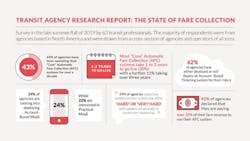The way transit agencies and operators purchase and run ticketing (fare collection) systems has not dramatically changed in decades. However, new ticketing channels, such as mobile ticketing, have come onto the market and have had a significant impact on how fare collection systems are run. With 64 percent of agencies now looking to introduce Account-Based Ticketing systems, where passengers no longer need to purchase a ticket or understand fares but instead simply tap and ride using a contactless bank card, mobile phone or smartcard, the need for innovation in core Automated Fare Collection (AFC) systems has never been more acute.
A new report titled ‘The State of Fare collection’ highlights the need for new ways of implementing fare collection. Based on insights from more than 60 North American transit agency professionals, the survey explored the impact AFC systems have on agencies’ ability to innovate and ultimately successfully implement a Mobility as a Service (MaaS) strategy.
The state of fare collection today
Core AFC systems are typically deployed using a Design Build Operate Maintain (DBOM) model. This bespoke approach offers the opportunity for agencies to have a customized solution and, until now, has been the only real choice for transit agencies around the world.
However, this way of delivering systems is beginning to show its limitations, making it hard for transit agencies to upgrade their fare collection system and keep up with the pace of technology. First of all, DBOM AFC systems are, according to the professionals surveyed, difficult to update – with 59% of agencies stating that making any updates to their system was either ‘Hard’ or ‘Very Hard’, and with updates occasionally or hardly ever happening as a result. On top of that, 43 percent of agencies have been operating their core AFC systems for over a decade. Meanwhile, survey respondents reported that most deployments typically took one to two years to go live (30 percent), with a further 11 percent taking over three years. Given the numerous technological advances that have appeared in recent years, it is clear that many transit agencies are being left stranded and unable to innovate due to the limitations and constraints of their core AFC systems.
This issue is about more than speed and flexibility, the strategic decision over what fare collection model to use impacts agencies’ bottom line too. When asked “Do you think your agency has received value for money?”, only 30 percent of respondents believed they had and 70 percent either did not know or did not think they were getting a good deal. While 34 percent of agencies declared that they are paying under 10 percent of their fare revenue to run their AFC system, a staggering 35 percent reported paying between 10 percent - 20 percent. This means that for every dollar that those companies earn, 10 to 20 cents are going back to covering fare payment and ticketing costs
Rethinking the cost model of their AFC systems could allow agencies to spend and invest on other parts of their businesses, helping them improve their public transit services. Similarly, if agencies are to be able to respond to the fast evolving wants and needs of their passengers, they cannot afford to be locked into bespoke systems that take an age to deploy and are time-consuming to upgrade.
A new model for fare collection
The emergence of Fare Payment as a Service (FPaaS) is changing this. The new FPaaS model enables agencies to move away from procuring their own systems and instead sign up to a fare payments platform -- a multi-tenant service, built and run centrally in a cloud hosting environment that can serve many transit agencies simultaneously. The FPaaS platform is constantly updated to deal with new security threats online, and constantly has new technologies and features added as they reach market acceptance and maturity which are then available for everyone on the platform to use. Instead of the new features being built, debugged and paid for individually by each agency at their own financial risk, the costs of adding new features is defrayed over the entire platform, allowing smaller agencies and large agencies to gain access to them without large new bespoke projects or upgrades. As the platform is constantly being updated, it also means that an agency won’t find that their core system becomes out of date or too old to update with new capabilities, which can happen with legacy “build and maintain” systems.
The FPaaS model is usually subscription-based or run on a Pay-as-You-Go basis meaning transit agencies pay only for what they use. By adopting FPaaS, agencies can reduce the cost of fare collection and use the money saved to deploy increased transport capacity and innovation to their organizations. Normally, FPaaS should cost up to half of the operating cost of legacy fare collection, and a small fraction of the up-front initial capital cost due to avoiding the initial bespoke development fees.
What this means is that, in contrast to bespoke core AFC systems, agencies can buy into a pre-existing and ready-to-deploy platform that can be launched rapidly off the shelf, configure it for their current needs, and take advantage of new features and capabilities introduced as a platform supplier adds them.
The three routes to enabling MaaS
FPaaS offers agencies an on-ramp to MaaS. MaaS combines public and private transportation options, ridesharing, public transit, bike-sharing and other shared mobility services into a single offering. Facilitating a seamless journey, MaaS promises to be a long-term alternative to car ownership, helping to reduce congestion in our cities. But it requires a ticketing and fare payment system that can integrate into these different apps and services, facilitating accessible and intuitive multimodal experiences for the riders.
This transformation is underway, with the survey of transit agencies revealing that 84 percent of respondents either researching or actively interested in implementing a MaaS-based offering. Digging deeper into this admittedly broad categorization, the ‘State of Fare collection’ report identified three approaches to MaaS – account-based, subscription-based and practical.
Subscription-based MaaS offers various transit options available via an app for a monthly fee. Services such as the Whim app in the UK’s second largest city Birmingham follow this model. However, this approach is less popular among US transit agencies – only five percent of survey respondents were interested in deploying subscription-based MaaS.
In contrast, account-based MaaS, which uses an account-based mobility card or token to enable travel by tapping on public and private vehicles, is implemented by a number of large agencies around the world. The survey found that an overwhelming majority of respondents are interested in deploying account-based ticketing, making it a popular and in-demand approach to MaaS.
However, while account-based may be the destination for public transit in cities, agencies of all sizes are looking for practical steps they can take today that can immediately begin delivering benefits for both the agency and its passengers.
With a practical MaaS approach, the ticketing and fare collection is integrated into existing apps which are already being adopted and used by people as part of their journey; for example ride-hailing apps such as Uber and journey planning apps such as Transit. Not only did the survey find that 22 percent of respondents are interested in deploying practical-MaaS, but it is also live with agencies across the US, as well as European and Asian markets. In Denver, for example, riders on Regional Transportation District (RTD) transit services can both plan their journey and buy their public transport tickets within both the Transit and Uber apps. As Uber’s Head of Transit David Reich put it: “For the first time ever, taking an Uber trip can mean taking public transit.”
This Uber/RTD integration is a prime example of how a practical approach to MaaS can directly address perhaps the major determinant as to whether people choose to use public transit for all/part of their journey – convenience. A multimodal public and shared private approach is a key element to encouraging more people to take fewer private car journeys, which in turn reduces congestion and pollution.
By making fare payment for public transit available through apps such as Uber and Transit, agencies of all sizes can quickly and cost effectively integrate ticketing into already popular MaaS apps, helping more people seamlessly and conveniently discover and access public transit services while accelerating their own journey to a MaaS-enabled transit system.
------




